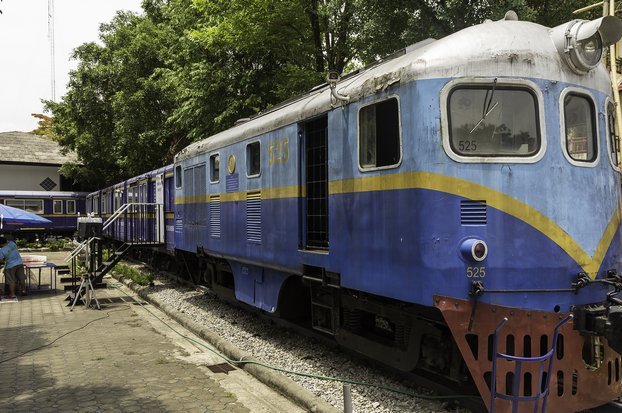
Aside from the surge of upcoming electric train projects in Bangkok, the government has also been boosting the construction of several provincial train routes across the country, many of which have previously been delayed.
Transport Minister Arkhom Termpittayapaisith revealed during a visit to the State Railway of Thailand (SRT) last month that plans for two out of nine routes in the second phase of double-track rail development will be submitted to the cabinet by the end of this month.
They are double-track railway routes from Den Chai to Chiang Khong (in Chiang Rai, bordering Lao PDR) and Ban Phai (in Khon Kaen) to Nakhon Phanom.
The nine routes in the second phase of the SRT's double-track railway master plan are worth 398 billion baht.
SRT acting governor Anon Luangboriboon said the Den Chai-Chiang Khong route would ideally be the first railway to get the cabinet green light, since plans for the route are by far the most complete.
In fact, talks over the route's construction actually began over five decades ago, in 1960, with land inspections later being conducted in 1969.
Land expropriation for the project originally began in 2001, before the government instructed transport authorities three years later to conduct new studies into how the project will connect to China's expanding railway networks in the future.
SRT reports say that construction was initially meant to begin last year, but authorities now insist plans for the route will be on the cabinet's table this month.
At present, the new northern route is set to be around 323km long, with 26 stations. The 77-billion-baht project will stretch across four of the country's northern provinces -- Phrae, Lampang, Phayao and Chiang Rai.
Three of the 26 stations planned for the Den Chai-Chiang Khong route -- Phrae, Phayao and Chiang Rai stations -- will be constructed as major hubs.
The route will use a meter-gauge railway system, and aims to also be used to transport cargo in addition to its main purpose of servicing passengers. The project will take up around 50-60m land width along its entire stretch.
The route is set to start at Den Chai station, in Phrae, which connects to Thailand's present Northern train line (Hua Lamphong to Chiang Mai).
It then travels up north, where it will enter Lampang through the province's Tambon Mae Tip station in Ngao district. Further north, the route will enter Phayao through Phayao University station.
After reaching Chiang Rai through Pa Daet district station, the route's terminus will lie in the province's Chiang Khong district.
Upon its completion, Chiang Khong station will also be used as a cargo depot area, since it borders neighbouring Laos.
A separate depot is set to be constructed on a 336-rai stretch of land nearby the Fourth Thai-Lao Friendship Bridge, crossing the Mekong River.
Such efforts are part of a government initiative to bolster trade along the Thai-Lao border. Chiang Khong, which connects to Huay Xai, the capital of Laos' Bokeo province, has been eyed as a major trading route, since it leads to the landlocked southwestern part of China through Laos.
Land Transport Department reports state the depot will cost an initial 1.36 billion baht to construct, and will be open by 2020.
According to SRT studies, the route will service upwards of 1.7 million passengers and 1.6 million tonnes of cargo per year once it is completed, with the number rising to 2.7 million yearly passengers and 4.25 million tonnes of cargo by 2037.
"People have been waiting for this project for over five decades," Transport Minister Arkhom said. "This year the project will finally be approved and subsequently constructed in the years to come."
He added that bidding for the route could begin in May, and it was expected that it might open by 2023.
For the Ban Phai to Nakhon Phanom double-track rail project in Thailand's northeast, the route will stretch across parts of Khon Kaen, Maha Sarakham, Roi Et, Mukdahan and Nakhon Phanom.
Comprising 14 stations, the route will begin at Khon Kaen's Ban Phai district, with its terminus being Nakhon Phanom station, also bordering Laos.
The terminus is set to be located nearby the Third Thai-Lao Friendship Bridge.
The 355km route has thus far been valued at 65 billion baht.
Mr Arkhom said after his visit to the SRT that the authority services an average of 35 million passengers per year. According to him, the number could rise to as high as 80 million yearly passengers by 2027, after all three phases of double-track development and construction are complete.
"We are trying to submit plans for all the train networks in the second phase by the end of the year, while plans for the third phase will be complete by the end of 2019 at the latest," Mr Arkhom said.
Construction of the first phase of the SRT double-track rail project began in 2016, and involves seven provincial routes, according to the authority's reports.
The seven routes, whose construction began in February 2016, stretch a collective 993km, and are worth a total of 113 billion baht.
"Once construction of all these railways is complete, the SRT's coverage of the country's land will increase from 47 provinces at present to 61 provinces," the transport minister said.